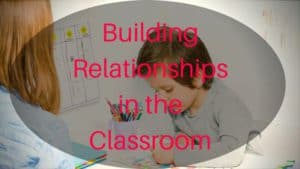 The whole team including the teacher, teacher assistants, administration staff and leadership team should work towards building a strong relationship with the student. In my experience often the student only develops a strong relationship with the teacher. This is limiting as the student needs to be able to respond to other staff in the playground, and often leadership teams are involved in behaviour management.
The whole team including the teacher, teacher assistants, administration staff and leadership team should work towards building a strong relationship with the student. In my experience often the student only develops a strong relationship with the teacher. This is limiting as the student needs to be able to respond to other staff in the playground, and often leadership teams are involved in behaviour management.
A strong relationship with the student means that the student will be more receptive to teaching opportunities and more likely to retain more information learnt from the teacher.
4 Key Ways to Build Rapport
- Get to know the student and his or her interests.
- Develop a summary profile of the student so everyone is aware of the student’s triggers.
- Know the students’ name (students on the spectrum often don’t realise you are speaking to them if you don’t include their name).
- Give students responsibilities or jobs particularly around their special interest.
Excerpt from: The Ultimate Guide to School and Home
Try the 2×10 strategy. Spend two minutes per day for 10 days in a row talking with an at-risk student about anything she or he wants to talk about. The strategy researched by Raymond Wlodkowski, is designed to build rapport and relationship between teacher and student, and lets the child see that you genuinely care about him or her as a person.
The amazing part is how it turns that abstract, overwhelming, where-do-I-start concept of relationship building into something easily manageable with an immediate payoff for everyone involved.
Raymond Wlodkowski did extensive observations of student behaviour and found an 85-percent improvement in student’s behaviour. In addition, he found that the behavior of all the other students in the class improved.
Remember when students act out, they are letting us know that they are seeking a positive connection with an adult figure and that they need that connection first, before they can focus on learning content.
3 Key Strategies for Maintaining Positive Relationships with Students and Children at School and Home
- Help children to build their competence
- When children feel competent they are moremotivated.
- Develop and nurture their natural talents and strengths.
- Avoid demands beyond their capabilities. Don’t placethem in embarrassing positions.
- Praise their effort, not just their ability.
- Avoid learned helplessness
- Too many experiences of failure can induce a sense ofhelplessness.
- Explain failure as a ‘way of learning’ instead of a resultof a ‘lack of ability.’
- Start with work they can achieve, then add work whichis more difficult. Use the 80/20 rule: 80% achievable/20% difficult.
- Avoid power struggles
- Power struggles create stress for everyone and slowlyerodes relationships between adult and child.
- Validate the child’s feelings.
- Teach the child coping strategies for particularsituations.



 Sorry we no longer ship items outside Australia. Please consider the digital versions of Sue’s Books –
Sorry we no longer ship items outside Australia. Please consider the digital versions of Sue’s Books – 